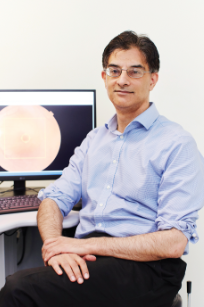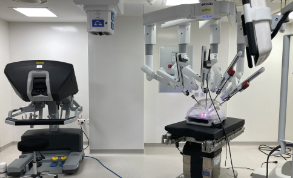Feature / Brain power
Ask the average person in the street to explain artificial intelligence (AI) and robotics and most will have a view informed by the dystopian visions of science fiction films. For now, the promise – or threat, depending on your view – of near-sentient machines remains a pipe dream. Nevertheless, even in its relatively unsophisticated state, AI is all around us, from personal digital assistants such as Siri and Alexa to new technologies supporting clinicians in our hospitals.
Recent health secretaries in England and the NHS long-term plan have backed digital technologies as a means to improve services to patients, as well as promoting efficiency. So, it is unsurprising that NHS technology adoption has increased. The pace of change has quickened in the wake of the Covid-19 pandemic. And moves to integrate services have highlighted the potential benefits of analysing huge chunks of data and the need to be flexible in the delivery of services to patients.
The HFMA has a role through its Delivering value with digital technologies programme. Supported by Health Education England, it aims to increase NHS finance staff awareness of digital healthcare technologies, and enable finance to take an active role in supporting the use of digital technology to transform services and drive value and efficiency.
Before looking in detail at how AI and robotics are being used in the NHS, it is worth asking what they are. There is no universally agreed definition of AI, but it may help to think about what we understand to be AI – a computer that can choose the correct response to the data it is given, whether that be asking a digital personal assistant to tell you a joke or sifting through thousands of images to select those that show a suspected cancer.
AI is intrinsically linked with two further terms – data science and machine learning – and often AI is used in reference to all three. Data science is about the analysis of data, and the insights gained, while machine learning can be an engine to achieve both by performing tasks without being explicitly programmed to do so.
In clinical practice, robotics can refer to real robotic arms that assist surgeons in keyhole surgery. A surgeon controls the arms with the system seamlessly translating their hand, wrist and finger movements into precise movements of surgical instruments.
This form of keyhole surgery can lead to reduced lengths of stay, less pain for the patient, fewer complications and faster recovery times (see box, Robotic precision, overleaf).
In the NHS, funding for AI projects has often come from the National Institute for Health Research and NHSX, now part of NHS England.
According to an HEE roadmap on the use of AI in the NHS, published last month, diagnostic technology such as imaging, pathology and endoscopy is the most common use of AI in healthcare. This was followed by automation or service efficiency.
In addition, HEE estimated that 56 AI technologies will undergo a large-scale deployment within a year, with 77% of these technologies used in secondary care, 23% in primary care and 7% in community care.
A total of 155 workforce groups across 67 clinical areas were identified to be using AI technologies, mostly in clinical radiology and general practice as well as non-clinical administrative staff.
Cancer care
The diagnosis and treatment of cancer is a major area for the application of AI in the NHS. The Royal Surrey NHS Foundation Trust, for example, is using AI in radiotherapy to target the tumours of patients with cervical cancer – a UK first. Using data from daily CT scans, the AI delivers prescription doses precisely to limit side-effects and damage to healthy tissue.
Last year, the trust was one of a group of bodies that won government funding to trial the use of AI in the diagnosis of breast cancer. Previous work had trained an algorithm to identify cancers, and the trial’s aims include determining the accuracy and fairness of the AI model.
Doctors at Addenbrooke’s Hospital in Cambridge are using an open source AI toolkit created by Microsoft Research to support diagnosis and speed up treatment. Funding for a range of projects at the hospital was provided by NHSX, including differentiating between cancerous
and healthy tissue.
Sam Godfrey, senior research information manager at Cancer Research UK, says AI offers huge potential in cancer care, particularly diagnostics, where early diagnosis can increase survival rates.
‘In the NHS, every cancer scan is assessed by two specialists,’ he explains. ‘If you could replace one with AI, then you would double capacity immediately.’
There are other promising areas, including using AI in treatment planning, giving oncologists more time face-to-face with patients.
Dr Godfrey believes that AI could be a useful tool for most cancers – Cancer Research UK is supporting a range of research projects that involve AI. However, he adds: ‘High-quality research is needed to explore whether we should always use it, and when best to use it. We don’t want to take out the human element.’
AI is not just a useful tool for cancer diagnosis and treatment. Moorfields Eye Hospital NHS Foundation Trust and the University College London Institute of Ophthalmology, in conjunction with several other bodies, are exploring the use of AI to detect diabetic retinopathy.
Impact on diabetes
Adnan Tufail (pictured), consultant ophthalmologist at Moorfields and the Institute of Ophthalmology, points out that diabetes is an increasing public health problem, especially among Asian and black African-Caribbean groups.
Diabetes-related costs to the NHS totalled £10bn in 2010/11, with 80% being spent on complications. Averting complications offers huge potential savings by reducing morbidity and mortality, Dr Tufail believes.
He says the early detection of diabetic retinopathy – which is the leading cause of blindness in the working population – through annual retina screening and grading of retinal photographs is key to avoiding sight loss. The NHS currently carries out more than 2.2 million screening episodes a year through its diabetic eye screening programme, but it is time- and labour-intensive, and costly, requiring humans to grade around 11 million retinal images annually.
‘There is an urgent need to reduce the workload on human graders, who are difficult to recruit and retain,’ Dr Tufail says. ‘Automated retinal image analysis systems (ARIAS) are AI algorithms that could safely triage sight-threatening diabetic retinopathy from those at low risk. Furthermore, they can grade a retinal image within seconds.’
However, he cites a concern: the algorithms are often developed largely using white and younger individuals, leading to higher rates of ungradable images in scans of those from minority ethnic groups.
Dr Tufail says the data generated from the assessment of available algorithms will support the commissioning of AI for diabetic screening, while live implementation will help iron out technical issues.
He adds: ‘Previous work from our group showed that certain AI systems were at least as good as human-trained graders at detecting diabetic eye disease on retinal colour photos, and specific enough to be cost saving to the NHS if implemented.
‘Previous studies by our group, with the London School of Economics, have shown that some AI algorithms for diabetic screening, if implemented, would save the NHS over £10m a year. With the current generation of ARIAS being tested, the cost saving is likely to be more.’
The AI could be rolled out across the NHS. ‘In diabetic screening alone, this live implementation study should pave the way for the commissioning and deployment of approved AI systems for the 2.2 million diabetics that need annual eye checks,’ he says. ‘Other screening programmes such as mammography could benefit from the methodology in this study, both for testing AI systems and monitoring them after mass deployment to ensure trustworthy AI for all.’
The NHS is only just beginning to use AI, but it shows promise as a tool to speed up diagnosis and care. If this potential can be harnessed, it will be good news for patients and service efficiency.
• Find out more about Delivering value with digital technologies – the HFMA programme supported by Health Education England
Robotic precision

The robotic-assisted surgery system was used at United Lincolnshire Hospitals NHS Trust (ULHT) for the first time in February as part of the treatment of a patient with prostate cancer. The trust says its £3.2m investment will offer more choice for urology and colorectal cancer patients as they undergo treatment.
Previously, patients had to travel outside the county for robotic surgery, explains consultant urologist Aris Alevizopoulos, who is based at Lincoln County Hospital. He has been performing robot-assisted procedures for cancer patients at Leicester General Hospital, as part of the East Mercia Urology Alliance with ULHT and University Hospitals of Leicester NHS Trust.
‘Having our own robotic-assisted surgery system in Lincolnshire will allow us to offer cancer surgery in a timely manner, and much closer to home for patients who would otherwise have been waiting up to three or four months for their procedure.
‘This robotic system upskills the operating surgeon and allows an advanced minimally invasive approach, which comes with a reduced risk of surgical complications, meaning those having surgery will be expected to go home earlier and have a faster recovery.’
The trust says the new system also supports its longer-term vision for improvements.
Paul Matthew, director of finance and digital, adds: ‘This is an exciting opportunity to further develop the services for people in Lincolnshire. Not only are we supporting greater choice in the available treatments, we hope to make significant reductions in waiting times for those in need of our care.’
Related content
We are excited to bring you a fun packed Eastern Branch Conference in 2025 over three days.
This event is for those that will benefit from an overview of costing in the NHS or those new to costing and will cover why we cost and the processes.